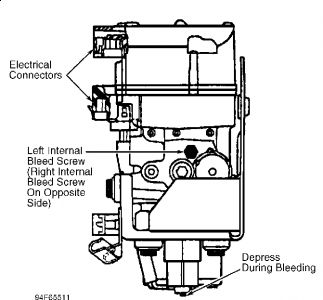MANUAL BLEEDING
1.Deplete vacuum reserve from power brake booster by depressing brake pedal several times with engine off. Fill master cylinder and keep at least half full during bleeding procedure. If master cylinder is not known or suspected to have air in bore, go to step 4). If master cylinder is known or suspected to have air in bore, go to next step. 2.Disconnect forward brakeline fitting at master cylinder. Allow fluid to flow from fitting. Tighten fitting to specification. See TORQUE SPECIFICATIONS . Have an assistant depress brake pedal slowly and hold. Loosen forward fitting. Tighten fitting while pedal is still at floor. Release brake pedal slowly. Wait 15 seconds.
NOTE: Rapid pumping of brake pedal causes master cylinder secondary piston to move into a position that makes bleeding system difficult.
3.Repeat step 2), including 15 second wait, until fluid is clear and free of air bubbles. Repeat procedure at other (rearmost) brakeline fitting on master cylinder. Master cylinder is now bled. If wheel cylinders/calipers are not suspected to have air in them, it is not necessary to bleed them.
NOTE: On vehicles with 4WAL, if Brake Pressure Modulator Valve was replaced, or is suspected to have air trapped inside, it must be bled next. See the appropriate ANTI-LOCK BRAKE SYSTEM article listed below. BLEEDING BRAKE SYSTEM
BRAKE PRESSURE MODULATOR VALVE (BPMV)
NOTE: It is not necessary to bleed BPMV during normal brake system bleeding. If BPMV is replaced or is suspected to have air in it, BPMV must be bled. Expect to use 2 quarts of fluid to thoroughly bleed system. Bleeding BPMV requires Tech 1 and appropriate cartridge.
1.Bleed BPMV after master cylinder, but before wheel cylinders/calipers. Ensure ignition is off. Install 2 Combination Valve Depressors (J-39177) on BPMV high pressure accumulator bleed stems. Install one combination valve depressor on combination valve. See Fig. 2 . Rotate 2 BPMV internal bleed valves 1/4-1/2 turn counterclockwise. See Fig. 3 . 2.Bleed wheel cylinders/calipers, using manual or pressure bleeding procedure. See the BRAKE SYSTEM article. Close BPMV internal bleed valves. Remove combination valve depressors from BPMV high pressure accumulator bleed stems. Remove combination valve depressors from combination valve.
CAUTION:If internal bleed screws are left open, hydraulic fluid will by-pass accumulator, and hydraulic pressure will be lost.
3.Connect Tech 1 scan tester with RWAL/4WAL cartridge or Mass Storage Cartridge to Data Link Connector (DLC). Ensure master cylinder fluid reservoir is full. Using Tech 1, perform 6 functional tests. All air should be removed from BPMV. 4.Rebleed wheel cylinders and calipers. This will remove any air in brakelines from purging BPMV. Evaluate brake pedal feel and braking performance. Repeat bleeding procedure if necessary.
Fig. 2: Depressing Combination Valve Courtesy of GENERAL MOTORS CORP.
Fig. 3: Locating BPMV Internal Bleed Valves
Courtesy of GENERAL MOTORS CORP.
Fig. 4: Identifying BPMV & Brakeline Routing
Courtesy of GENERAL MOTORS CORP.


Depending upon which system you have.
Thursday, March 5th, 2009 AT 7:36 PM





